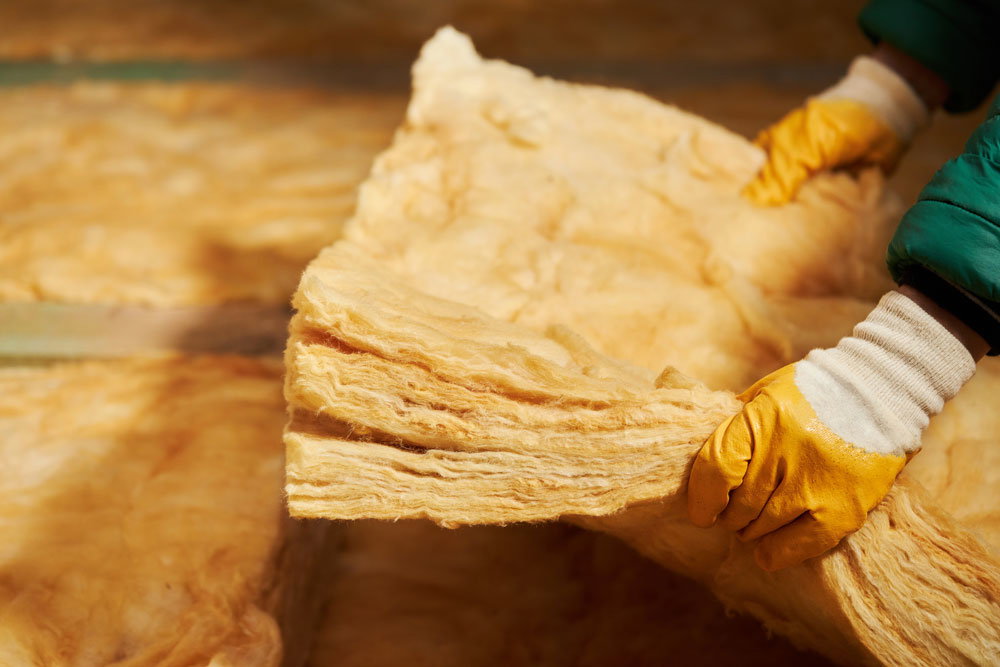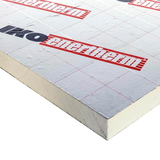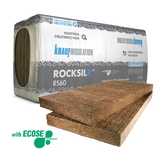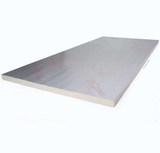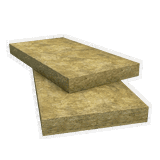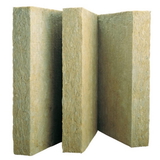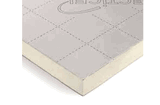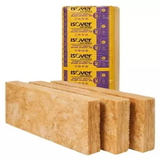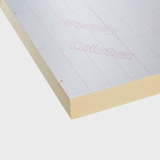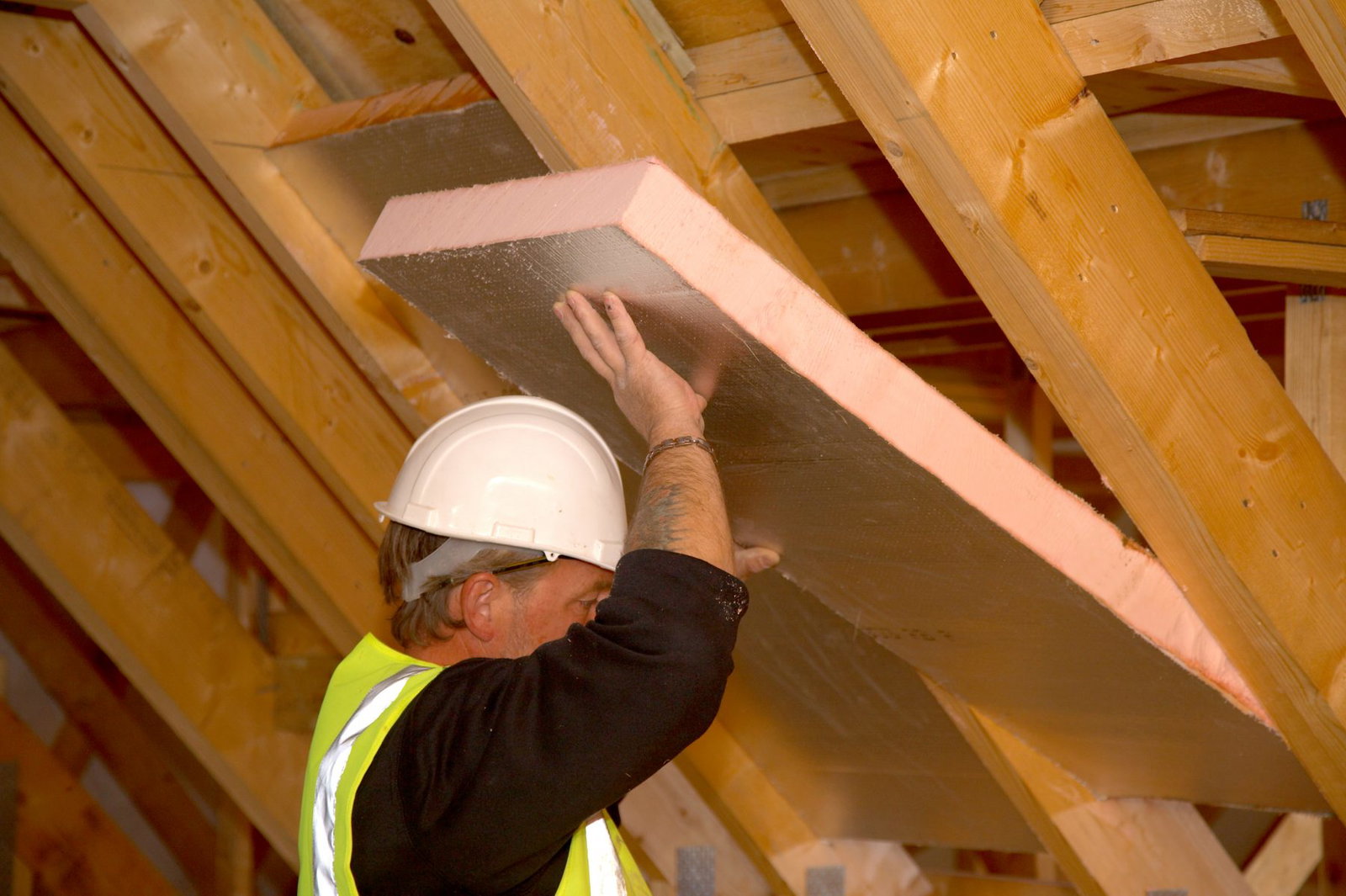- Blogs
- Choosing Your Insulation: PIR vs Rockwool vs Fibreglass Insulation
Choosing Your Insulation: PIR vs Rockwool vs Fibreglass Insulation
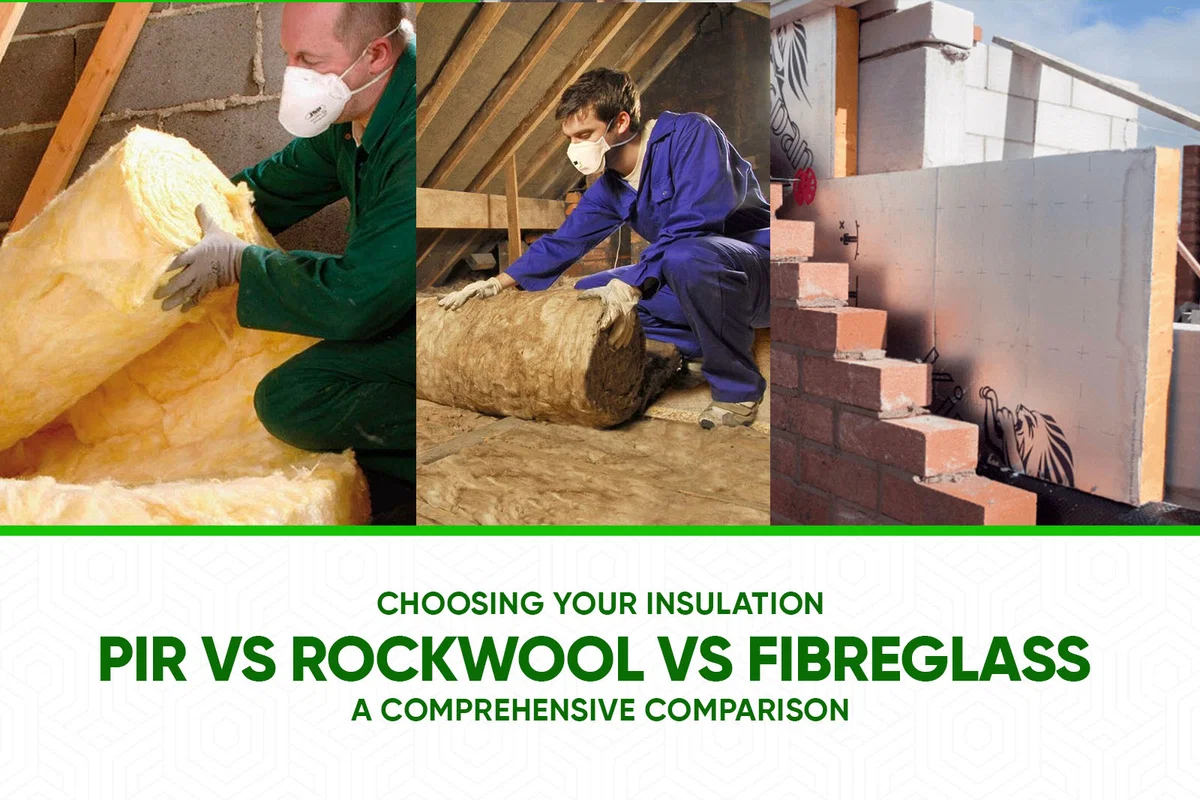
Effective insulation is paramount in UK homes, not just for comfort but as a critical measure for improving energy efficiency and curbing escalating heating bills. Against a backdrop of rising energy costs and heightened environmental awareness, the drive for better insulated properties is further underscored by UK Building Regulations, particularly Part L, which mandates improved energy performance in new and existing buildings. When considering insulation upgrades or specifying materials for new constructions, homeowners and building professionals are often faced with a choice between several popular materials.
This article provides a comprehensive comparison of three leading contenders in the UK insulation market: Polyisocyanurate (PIR) boards, Rockwool (a type of stone mineral wool), and Fibreglass (a type of glass mineral wool). The aim is to provide an unbiased, detailed examination of their respective properties, performance characteristics, and suitability for various applications.
By understanding the nuances of each material – from thermal conductivity and acoustic dampening to fire safety and moisture resistance – readers will be better equipped to make an informed decision that aligns with their specific project needs, budget, and long-term performance expectations. The decision-making process itself has grown more intricate; it's no longer solely about which material is "warmest."
Factors such as regulatory compliance, the overall value proposition considering lifespan, environmental footprint, and precise application suitability now play significant roles. This guide seeks to explain these complexities, offering clarity on "PIR vs Rockwool," "Rockwool vs Fibreglass insulation UK," and ultimately, helping to identify the "best insulation for UK homes" based on individual circumstances.
TLDR: Choosing Your Insulation
This article compares PIR (Polyisocyanurate), Rockwool (stone mineral wool), and Fibreglass (glass mineral wool) insulation for UK homes.
- PIR: Best for thermal efficiency in tight spaces due to its low thermal conductivity (around 0.022 W/mK). It's rigid, moisture-resistant but combustible (Euroclass E/F typically, though some systems achieve B).
- Rockwool: Excellent for fire safety (Euroclass A1, withstands over 1000 degrees C) and acoustic insulation. It's breathable and moisture-repellent. Thermal conductivity is good (around 0.032-0.044 W/mK).
- Fibreglass: Most budget-friendly, especially for DIY lofts. Good thermal (around 0.032-0.044 W/mK) and acoustic properties, and also fire-resistant (Euroclass A1/A2). Can be susceptible to moisture if not protected.
The best choice depends on your priorities: thermal performance in limited space (PIR), fire/acoustic needs (Rockwool), or budget (Fibreglass). Always consider proper installation and UK Building Regulations.
What Are They Made Of? ![]()
Before a direct comparison, it's essential to understand the fundamental composition and manufacturing of each insulation type, as these factors inherently dictate their performance characteristics. It's also important to clarify terminology: "mineral wool" is a broad category that includes both stone wool (like Rockwool) and glass wool (fibreglass). This article will treat Rockwool and Fibreglass as distinct materials within that broader mineral wool family.
PIR (Polyisocyanurate) Insulation Explained
Polyisocyanurate, commonly known as PIR, is a type of rigid thermoset polymeric foam insulation. It is typically manufactured as boards, faced on both sides with materials such as aluminium foil or other specialised facings. The manufacturing process involves a chemical reaction between MDI (methylene diphenyl diisocyanate) and polyol resin, along with a blowing agent. This reaction creates a rigid foam with a mainly closed-cell structure, where the blowing agent (an insulating gas) is trapped within the tiny cells. This structure is key to PIR's high thermal efficiency.
PIR insulation is precisely engineered from first principles to achieve specific and repeatable performance characteristics, unlike some natural materials where performance can vary. This engineering allows for a robust, rigid material that does not melt when heated. Many well-known brands in the UK market, such as Celotex, Kingspan, Recticel, Unilin (which acquired Xtratherm), and IKO, produce PIR insulation boards. The facings on PIR boards are not merely for structural integrity; low-emissivity foil facings, for example, can reflect radiant heat, further improving the board's thermal performance, and also contribute significantly to its moisture resistance by acting as a vapour barrier.
Rockwool (Stone Mineral Wool) Insulation Uncovered
Rockwool is a specific brand name that has become synonymous with stone mineral wool insulation. This material is manufactured primarily from natural volcanic rock, such as basalt or diabase, and often includes recycled slag, an industrial by-product from steel production. The manufacturing process is energy-intensive, involving melting these raw materials at extremely high temperatures (around 1500 degrees C). The molten material is then spun at high speed to create fine, intertwined fibres, forming a wool-like texture. These fibres are typically bound together with a thermosetting resin and may have mineral oils added to reduce dust and improve water repellency.
Rockwool insulation is available in various forms to suit different applications, including rigid or semi-rigid slabs (often referred to as batts), flexible rolls, and loose-fill granulate for blowing into cavities. It is generally denser and heavier than fibreglass mineral wool, a characteristic that contributes to its excellent acoustic insulation and fire resistance properties.
Fibreglass (Glass Mineral Wool) Insulation Detailed
Fibreglass insulation, also commonly referred to as glass wool, is another prominent type of mineral wool. As its name suggests, it is made mainly from glass, often with a significant proportion of recycled glass content, mixed with sand and other raw materials. The manufacturing process is similar to that of Rockwool: the glass mixture is melted at high temperatures and then spun into fine fibres. These fibres are then typically bound together with a resin to form a resilient, flexible blanket of insulation.
Fibreglass insulation is widely available in the UK in several forms, most commonly as lightweight rolls, which are often pre-perforated to fit standard joist spacings in lofts, making DIY installation easier. It also comes in slab or batt form and as loose-fill for blown applications. Compared to Rockwool, fibreglass is generally lighter and more flexible. Popular UK brands for fibreglass insulation include Knauf Insulation and Isover (part of Saint-Gobain). The fibrous nature of glass wool creates millions of tiny air pockets, which are responsible for its ability to trap heat and provide thermal insulation.
Head-to-Head Performance Comparison
With a foundational understanding of what these insulation materials are, it is now possible to compare their performance across several key criteria crucial for UK building projects.
Keeping the Heat In: Thermal Performance (Thermal Conductivity & R-Values)
The primary function of insulation is to reduce heat transfer. Two key metrics define how well a material achieves this: the Lambda value and the R-value.
The Lambda value, measured in Watts per metre-Kelvin (W/mK), indicates the thermal conductivity of a material. It signifies how easily heat passes through a specific material, irrespective of its thickness. For insulation purposes, a lower lambda value is always better, as it means less heat will conduct through the material.
The R-value, measured in square metres Kelvin per Watt (sq m K/W), represents the thermal resistance of a material. It indicates how well a material resists the flow of heat. Unlike the lambda value, the R-value is dependent on both the material's intrinsic thermal conductivity (lambda) and its thickness – the thicker the material, the higher its R-value. For insulation, a higher R-value is better.
Building Regulations in the UK often specify target U-values for different building elements (walls, roofs, floors). The U-value is the overall heat transfer coefficient, essentially the inverse of the total R-value of all layers in a construction element, plus surface resistances. A lower U-value indicates better insulation and less heat loss.
PIR Insulation
PIR typically boasts the lowest lambda values among the three common insulation types. Standard PIR boards commonly achieve a lambda value of around 0.022 W/mK. Some premium PIR products, such as Kingspan's Kooltherm range, can achieve even lower lambda values, down to 0.019 W/mK or 0.020 W/mK. This exceptional thermal conductivity translates into very high R-values per unit of thickness. For instance, PIR insulation can offer an R-value of approximately 5 to 6 per inch (or around R-0.20 to R-0.24 per mm). The significant implication of this is that less thickness of PIR insulation is required to achieve a specific target U-value compared to mineral wools. This makes PIR an ideal choice for applications where space is limited, as it can help maximise usable internal floor space or fit within restricted cavity depths. This space-saving benefit can have tangible architectural and even structural cost advantages, potentially allowing for thinner wall or roof constructions.
Rockwool (Stone Mineral Wool)
Rockwool insulation typically has lambda values ranging from 0.032 W/mK to 0.044 W/mK. However, advancements in manufacturing, such as Rockwool's NyRock® technology, have led to products with improved thermal performance, achieving lambda values as low as 0.032 W/mK. This development is noteworthy as it begins to close the thermal performance gap with PIR, offering a more thermally efficient mineral wool option. Generally, Rockwool provides good R-values, typically in the range of 3.0 to 4.3 per inch (or around R-0.12 to R-0.17 per mm). While it requires more thickness than PIR to achieve the same level of thermal resistance, Rockwool offers other compelling benefits in areas like fire safety and acoustics.
Fibreglass (Glass Mineral Wool)
Standard fibreglass insulation often has lambda values in a similar range to conventional Rockwool, typically between 0.032 W/mK and 0.044 W/mK. Common fibreglass loft rolls, for example, frequently have a lambda value of 0.044 W/mK. Consequently, the R-values for fibreglass are generally lower than PIR and often Rockwool for the same thickness, typically around 2.2 to 2.7 per inch (or around R-0.09 to R-0.11 per mm) for many standard products, although some higher-density fibreglass products can achieve R-values up to 3.8 per inch. This means that fibreglass usually requires the greatest thickness of the three to meet a specific thermal performance target, but it is often the most cost-effective option on a per-square-metre basis.
It's important to recognise that while lambda values are intrinsic properties, the installed thermal performance can be influenced by the quality of installation. Gaps, voids, or compression of mineral wool insulation can significantly reduce its effectiveness. PIR boards, due to their rigidity, may offer more consistent installed performance if joints are properly sealed, as they are less prone to compression issues.
Thermal Performance at a Glance
| Material Type | Typical Lambda Value Range (W/mK) | Typical R-Value per inch (approx.) | Approx. Thickness for R-4.5 (100mm equivalent of 0.022 lambda) |
| PIR | 0.019 - 0.022 | 5.0 - 6.0 | approx 75-90 mm |
| Rockwool (Stone Wool) | 0.032 - 0.044 | 3.0 - 4.3 | approx 105-150 mm |
| Fibreglass (Glass Wool) | 0.032 - 0.044 | 2.2 - 3.8 | approx 120-170 mm |
(Note: R-values per inch are approximate and can vary by specific product and density. Thickness for R-4.5 is illustrative, actual thickness will depend on the precise lambda value of the chosen product.)
Where Do They Fit? Common UK Applications
All three insulation types find widespread use in UK construction, but their distinct properties often make one more suitable than others for particular applications.
Lofts (Pitched Roofs at Ceiling Level - Cold Roofs)
-
Fibreglass & Rockwool Rolls/Batts: These are the traditional and often most cost-effective choices for insulating between and over joists in accessible lofts. They are relatively easy for DIY installation. Current UK recommendations often suggest a depth of at least 270mm for loft insulation to meet energy efficiency targets.
-
PIR Boards: Can be used in lofts, particularly if the space is intended for storage (where boards can be laid over joists to provide a firm surface) or if headroom is severely restricted, leveraging PIR's higher R-value per thickness. PIR is also frequently used in "room in roof" or loft conversion scenarios, installed between and often over or under the rafters to maximise insulation in a limited space.
Cavity Walls
The space between the two leaves of a cavity wall is a prime location for insulation.
-
PIR Boards: Widely specified for both partial and full-fill masonry cavity wall insulation. Their high thermal performance allows target U-values to be met within relatively narrow cavities. Boards often feature tongue-and-groove edges and foil facings, which help to resist water penetration from wind-driven rain and improve thermal performance by reducing air leakage and reflecting radiant heat.
-
Rockwool Slabs/Batts: Specialised stone wool cavity slabs (e.g., Rockwool Cavity Slab 32, Knauf DriTherm Cavity Slab 37) are designed for full or partial fill applications. They offer a combination of good thermal insulation, excellent acoustic dampening, and superior fire resistance. These products are typically water repellent.
-
Fibreglass Slabs/Batts: Glass wool slabs, such as Knauf DriTherm, are also used for cavity wall insulation, providing a cost-effective solution.
The evolution of cavity wall insulation products, including PIR with interlocking edges and specialised mineral wool batts, reflects ongoing efforts to improve thermal bridging performance and moisture resistance in this critical building element.
Solid Walls (Internal or External Insulation)
Many older UK properties have solid walls, which lose significantly more heat than cavity walls.
-
PIR Boards: An excellent choice for internal wall insulation (IWI) on solid walls due to their ability to provide high levels of insulation with minimal thickness, thereby reducing the loss of internal room space. PIR boards can be fixed to the wall using battens or the "dot and dab" adhesive method. They are also used in External Wall Insulation (EWI) systems, applied to the outside of the building.
-
Rockwool Slabs: Also used for both IWI and EWI, Rockwool slabs contribute thermal insulation, acoustic benefits, and fire resistance to solid wall constructions.
-
Fibreglass: Can be incorporated into stud frames built against the internal face of a solid wall. Insulated plasterboards with a fibreglass backing are also available.
Solid wall insulation, particularly IWI, presents a balance between achieving thermal performance, minimising loss of internal space, and managing moisture effectively. While PIR's slim profile is advantageous, the breathability of mineral wools (when part of a carefully designed system) can be beneficial for older, solid-walled buildings where moisture movement through the wall is a consideration.
Floors (Suspended Timber, Concrete Slab)
-
PIR Boards: Commonly used for insulating floors due to their good compressive strength and high thermal efficiency. They can be installed under concrete screeds in solid floors, or between and over joists in suspended timber floors. While PIR has good compressive strength, for applications with very high loads, Extruded Polystyrene (XPS) might sometimes be preferred.
-
Rockwool Slabs: Suitable for insulating suspended timber floors between the joists, where they also offer acoustic benefits by reducing sound transmission between floors.
-
Fibreglass Rolls/Batts: A cost-effective option for insulating between the joists in suspended timber floors.
Flat Roofs
-
PIR Boards: A very common choice for warm flat roof constructions, where the insulation is placed above the structural deck. PIR's high thermal efficiency, structural rigidity, and compatibility with various waterproofing membranes make it well-suited for this application.
-
Rockwool Slabs: Can be used in flat roof systems, especially where improved fire resistance or acoustic performance is a primary requirement.
Pitched Roofs (Warm Roofs - Insulation at Rafter Level)
Creating a "warm roof" involves placing insulation at the rafter line, making the loft space part of the conditioned volume of the house.
-
PIR Boards: Ideal for this application due to their high thermal performance, allowing for significant insulation within the limited depth of rafters, or when applied over or under them.
-
Rockwool Slabs/Flexi-Slabs: Products like Rockwool Flexi-Slab are designed to be friction-fitted between rafters, providing thermal, acoustic, and fire benefits.
-
Fibreglass Rolls/Batts: Can also be installed between rafters in a warm roof design.
The choice for any specific application often involves a trade-off. For instance, in a loft conversion where maximising headroom is crucial, PIR's slim profile for a given R-value might be the deciding factor, even if it is more expensive or offers less acoustic improvement than Rockwool.
Peace and Quiet: Acoustic Insulation Properties
Beyond thermal comfort, insulation can play a vital role in creating a quieter indoor environment by reducing noise transmission.
PIR Insulation
Acoustic insulation is generally not a primary strength of PIR. Its rigid, closed-cell foam structure is less effective at absorbing sound energy compared to softer, fibrous materials. In fact, the rigidity of PIR can sometimes lead to it vibrating and transmitting sound. Some specialised PIR products may be available as part of a system that includes additional acoustic layers to improve sound dampening.
Rockwool (Stone Mineral Wool)
Rockwool is widely recognised for its excellent acoustic performance. This is attributed to its high density and its non-directional, open-porous fibrous structure. These characteristics allow Rockwool to effectively absorb sound waves, reduce reverberation, and dampen vibrations. It is frequently specified in applications where noise reduction is a key objective, such as in party walls between adjoining properties, floors separating flats, internal partition walls, and around noisy building services like plumbing or ventilation systems. The acoustic benefits of Rockwool contribute significantly to overall occupant comfort and well-being, an increasingly important consideration in modern building design.
Fibreglass (Glass Mineral Wool)
Fibreglass also offers good acoustic insulation properties, again due to its fibrous structure which traps and dissipates sound energy. It is generally considered an effective sound dampening material for many common residential applications. While high-density Rockwool often has an edge, particularly in attenuating low-frequency sounds, fibreglass provides a good balance of acoustic performance and cost-effectiveness for general noise control. The choice between Rockwool and fibreglass for acoustics may therefore depend on the specific noise reduction targets, the frequencies of concern, and the project budget.
Facing the Flames: Fire Performance and Safety
Fire safety is a non-negotiable aspect of building design and material selection. The reaction of insulation materials to fire is a critical consideration. In the UK and Europe, the Euroclass system (BS EN 13501-1) is used to classify the reaction to fire of construction products. This system grades materials from A1 (non-combustible, highest performance) down to F (easily flammable, lowest performance). Additionally, there are subclassifications for smoke production ('s' rating: s1 for little or no smoke, s2 for medium smoke, s3 for high smoke) and for the production of flaming droplets or particles ('d' rating: d0 for no droplets, d1 for some, d2 for many).
PIR Insulation ![]()
PIR is an organic material and is therefore combustible. The fire performance of PIR insulation can vary significantly depending on its specific formulation and whether it is a standalone board or part of an engineered insulated panel system.
-
Standard PIR insulation boards often achieve a Euroclass E or F rating. For example, Celotex XR4000 is rated Euroclass F, and general Celotex PIR products are typically Euroclass E.
-
However, some specialised PIR products, particularly when incorporated into insulated metal panel systems (as manufactured by companies like Kingspan or for specific applications like EPIC-member panels), can achieve much better fire ratings, such as Euroclass B-s1,d0. This improved performance is due to the engineered PIR core in these systems, which is designed to form a stable char when exposed to fire. This char layer can protect the insulation beneath and help the panel to self-extinguish once the external fire source is removed.
-
The combustion of PIR insulation can produce toxic gases, including carbon monoxide (CO), carbon dioxide (CO2), oxides of nitrogen (NOx), and, significantly, hydrogen cyanide (HCN). This is a serious life-safety concern.
-
Due to its combustible nature, the use of PIR insulation in the external walls of buildings above certain heights (e.g., 11 metres in Scotland, 18 metres in England and Wales for certain building types) is restricted by Building Regulations. The scrutiny following the Grenfell Tower fire, where PIR insulation was present, has led to much tighter regulations regarding combustible materials in facades.
Rockwool (Stone Mineral Wool)
Rockwool offers outstanding fire performance.
-
It is non-combustible and typically achieves the highest Euroclass A1 rating.
-
Being made from volcanic rock, it can withstand temperatures in excess of 1000 degrees C without melting or losing its structural integrity.
-
Rockwool does not contribute to fire spread and acts as a fire barrier, helping to compartmentalise fire and slow its progress through a building.
-
Crucially, it does not produce significant quantities of toxic smoke when exposed to fire.
-
Its excellent fire properties make it suitable for fire-stopping applications and for protecting structural elements.
Fibreglass (Glass Mineral Wool)
Fibreglass also provides excellent fire resistance.
-
It is non-combustible and typically achieves a Euroclass A1 or A2-s1,d0 rating.
-
The melting point of glass fibres is lower than that of stone fibres, generally around 500 degrees C to 700 degrees C. While this is less than Rockwool, it is still sufficiently high to provide good fire resistance in most building fire scenarios.
-
Fibreglass does not significantly contribute to fire spread or produce hazardous levels of smoke.
The distinction between "non-combustible" (Euroclass A1/A2) for mineral wools and "combustible" (even if fire-retardant) for PIR is fundamental. Non-combustible materials do not provide fuel for a fire, a significant inherent safety advantage. While some PIR systems are engineered to perform well in specific fire tests, the base material is organic and can burn, contributing to the fire load and releasing potentially more hazardous combustion products than inorganic mineral wools. The issue of toxic smoke is particularly critical; in a fire, smoke inhalation is a primary cause of casualties.
Fire Performance Overview
| Material Type | Typical Euroclass Rating (Reaction to Fire) | Combustibility | Smoke Production (Typical) | Flaming Droplets (Typical) | Key Fire Safety Notes |
|---|---|---|---|---|---|
| PIR (Standard Board) | E or F | Combustible | Can be significant, potentially toxic (HCN) | Varies | Check specific product data; use restricted in some high-rise applications. |
| PIR (in specific systems) | Can achieve B-s1,d0 | Combustible (core) | s1 (Little/no smoke for system) | d0 (No droplets for system) | Performance is system-dependent; core is still organic. |
| Rockwool (Stone Wool) | A1 | Non-combustible | Minimal (s1 equivalent) | None (d0 equivalent) | Withstands greater than 1000 degrees C; acts as fire barrier; no significant toxic smoke. |
| Fibreglass (Glass Wool) | A1 or A2-s1,d0 | Non-combustible | Minimal (s1 equivalent) | None (d0 equivalent) | Melts at approx 500-700 degrees C; does not contribute to fire spread. |
Battling the Damp: Water Repellency, Moisture Resistance, and Breathability
Managing moisture is crucial for the longevity of a building and the effectiveness of its insulation. This involves considering how materials interact with both liquid water and water vapour. "Breathability" refers to a material's vapour permeability – its ability to allow water vapour to pass through it. This is quantified by the water vapour resistance factor (mu-value) or vapour resistance (often measured in MNs/g). A low mu-value (close to 1, like air) or low MNs/g value indicates high vapour permeability (very breathable). A high mu-value or high MNs/g value indicates low vapour permeability (a vapour barrier).
PIR Insulation
-
Water Resistance: PIR's closed-cell foam structure makes it inherently resistant to moisture absorption. The foil facings commonly used on PIR boards further improve this water resistance, acting as an effective barrier to liquid water.
-
Waterproof? While highly water-resistant, PIR insulation is not completely waterproof. Prolonged exposure to excessive amounts of water or submersion can eventually lead to some water uptake and potential degradation of the material.
-
Vapour Permeability (Breathability): PIR insulation, especially when foil-faced, has very low vapour permeability. It acts as a vapour barrier. The water vapour resistance factor (mu-value) for foil-faced PIR is very high (effectively infinite for practical purposes, meaning it blocks vapour diffusion). Even PIR with more permeable facings has a mu-value typically in the range of 30-50, still making it a significant vapour retarder.
-
Mould Resistance & System Design: Due to its moisture resistance, PIR is generally resistant to mould growth on its surface. However, because it is a vapour barrier, careful consideration must be given to condensation risk within the overall construction. If warm, moist indoor air bypasses or penetrates the PIR layer and reaches a cold surface, condensation can occur. Therefore, PIR installations often require meticulous sealing of joints (e.g., with foil tape) to ensure vapour tightness, and the overall construction design must manage moisture effectively, potentially incorporating ventilation strategies.
Rockwool (Stone Mineral Wool)
-
Water Repellency: Rockwool fibres are typically treated during manufacturing to be hydrophobic, meaning they repel liquid water. Water tends to bead up and drain away rather than being absorbed into the fibres.
-
Moisture Resistance: While the fibres repel water, if the insulation is subjected to significant wetting (e.g., from a leak), water can pass through the open structure. However, Rockwool does not hold onto this moisture; it is designed to dry out quickly and effectively, retaining its structural integrity and full insulating performance once dry.
-
Vapour Permeability (Breathability): Rockwool is highly vapour permeable, or "breathable." It allows water vapour to pass through it easily. Its water vapour resistance factor (mu-value) is typically 1, the same as air, meaning it offers virtually no resistance to vapour diffusion.
-
Mould Resistance & System Design: Being inorganic and non-absorbent of moisture into its fibres, Rockwool is inherently resistant to mould, mildew, and rot. Because it is breathable, it is often used in "breathing constructions," particularly in timber frame buildings or for insulating older solid walls. In such systems, a Vapour Control Layer (VCL) is typically installed on the warm (interior) side of the Rockwool to limit the amount of moisture vapour entering the structure from inside, and a breathable membrane is often used on the cold (exterior) side to allow any vapour within the structure to escape outwards while preventing liquid water ingress.
Fibreglass (Glass Mineral Wool)
-
Water Repellency/Resistance: Standard, untreated fibreglass insulation can absorb and hold moisture if it gets wet. This can significantly reduce its thermal effectiveness and can lead to sagging or slumping of the insulation. Some fibreglass products may be treated to improve water repellency.
-
Vapour Permeability (Breathability): Unfaced fibreglass is highly vapour permeable, similar to Rockwool, allowing water vapour to pass through it easily. Its mu-value is also very low, around 1.
-
Mould Resistance & System Design: If fibreglass becomes damp and remains so for extended periods, it can support mould growth on its surface or, more commonly, on adjacent organic materials like timber or plasterboard. To perform effectively and avoid moisture-related problems, fibreglass insulation almost always needs to be part of a system that includes a well-installed VCL on its warm side and, in many applications (like timber frame walls or ventilated roofs), a breathable membrane on its cold side. The aim is to keep the insulation dry.
The UK's Building Regulations and standards like BS 5250: Management of Moisture in Buildings provide extensive guidance on controlling condensation and moisture in buildings. This standard emphasises a holistic approach to moisture management, considering the properties of all materials in a construction assembly and the way they interact. The choice between a "vapour-closed" approach (often associated with PIR) and a "vapour-open" or "breathable" approach (often associated with mineral wools) depends heavily on the type of construction, the local climate, and the internal environmental conditions of the building. Neither approach is inherently superior; both can be effective if designed and executed correctly.
Moisture Handling & Breathability
| Material Type | Water Repellency/Resistance | Vapour Permeability (Breathability) | Typical Water Vapour Resistance Factor (mu-value) | Typical Vapour Resistance (MNs/g per 100mm) | Notes on Mould Resistance & System Design (VCLs/BMs) |
|---|---|---|---|---|---|
| PIR (Foil-Faced) | High resistance to moisture absorption; foil acts as barrier. | Very Low (acts as vapour barrier). | Very High (e.g., 30-50 for permeable coated, effectively infinite for waterproof coated). | Very High (e.g., greater than 150 for 100mm foil-faced) | Good mould resistance. Requires careful sealing of joints. Overall construction needs to manage interstitial condensation. |
| Rockwool (Stone Wool) | Hydrophobic (fibres repel water); drains and dries out. | Very High (breathable). | approx 1. | Very Low (approx 0.005 for 100mm) | Excellent mould resistance. Used in breathable constructions; requires VCL on warm side and often a breathable membrane on cold side. |
| Fibreglass (Unfaced Glass Wool) | Can absorb moisture if unprotected; some products treated. | Very High (breathable). | approx 1. | Very Low (approx 0.005 for 100mm) | Can support mould if persistently damp. Requires VCL on warm side and often a breathable membrane on cold side to keep insulation dry and allow structure to breathe. |
(Note: Vapour resistance values are indicative and can vary. 1 MNs/g is a high resistance. mu-value=1 means it's as permeable as air. Vapour resistance (MNs/g) = mu-value times thickness (m) / 0.2 (approx. conversion factor for air's vapour permeability in g.m/MN.s).)
Common UK Product Examples
To provide context, it is helpful to understand some common product names in the UK market. These names often indicate the material's properties or intended use.
For mineral wool, product codes often relate to the density of the slab, which is a key factor in its acoustic and thermal performance.
- Rockwool RWA45: This is a versatile stone wool slab with a density of 45 kg/m³. It is a general-purpose product used widely for its excellent balance of thermal, acoustic, and fire (Euroclass A1) insulation properties in walls, floors, and ceilings.
- Knauf Rocksilk RS45/RS60: This is a similar range of rock mineral wool slabs from Knauf, with densities of 45 kg/m³ (RS45) and 60 kg/m³ (RS60) respectively. The higher density of RS60 provides enhanced acoustic insulation, making it a common choice for soundproofing applications.
For PIR insulation, product ranges are often distinguished by their thickness and primary application.
- Celotex GA4000: This stands for 'General Application' PIR board. It is a multi-purpose product available in a range of common thicknesses (e.g., 50mm to 100mm) and is suitable for a wide variety of uses in floors, walls, and roofs.
- Celotex TB4000: This stands for 'Thermal Bridging'. This range consists of thinner PIR boards (e.g., 20mm to 40mm) specifically designed to tackle thermal bridges—areas where heat can escape more easily, such as around window reveals or steel beams.
Built to Last? Durability and Lifespan
The longevity of insulation is a key factor in its overall value and environmental impact.
PIR Insulation ![]()
PIR boards are known for their high durability. Being rigid and having a closed-cell structure, they are resistant to moisture ingress (when facings are intact) and do not typically compress, settle, or sag over time if installed correctly. This dimensional stability ensures that their thermal performance remains consistent. The lifespan of PIR insulation can be very long, often cited as lasting for the entire life of the building, potentially in excess of 50 years, provided it is not physically damaged or subjected to prolonged, excessive moisture.
Rockwool (Stone Mineral Wool)
Rockwool is an extremely durable material. Being manufactured from inorganic rock fibres, it is inherently resistant to rot, mould, decomposition, and attack by vermin. It does not shrink or sag over time and maintains its physical properties and thermal performance for many decades. Lifespans of 65 years or more are often quoted for Rockwool products, with some sources indicating performance can last for the lifetime of the building. While generally resistant to compression, it is important to use the correct density of Rockwool for the specific application (e.g., higher density for floors). Significant structural settling of a building could potentially compress any type of insulation.
Fibreglass (Glass Mineral Wool)
The durability of fibreglass insulation is generally good, provided it is kept dry and remains undisturbed. Its lifespan can be considerable, with typical estimates ranging from 20 to 30 years, although under ideal, stable conditions, it could last much longer, potentially up to 80 or even 100 years. However, fibreglass is more susceptible to certain issues than PIR or Rockwool. It can sag, compact, or become displaced over time, particularly if it is disturbed (e.g., in a loft space used for storage) or if it becomes wet. Compression significantly reduces its thermal effectiveness because it relies on trapped air. If not adequately protected, it can also be susceptible to damage from pests.
The inherent robustness of PIR and Rockwool against common issues like moisture and settlement generally gives them an advantage in terms of consistent long-term performance compared to standard fibreglass, whose real-world lifespan can be more variable. The "does not settle or sag" characteristic of PIR and denser Rockwool products is crucial for maintaining continuous insulation coverage and preventing thermal bridges.
The Green Question: Environmental Impact and Sustainability
With growing environmental consciousness, the sustainability credentials of building materials are increasingly under scrutiny. This includes raw material sourcing, manufacturing impacts, recycled content, operational lifespan, and end-of-life disposal or recyclability. Environmental Product Declarations (EPDs) provide standardised data on these aspects.
PIR Insulation
-
Raw Materials & Manufacturing: PIR is manufactured from petrochemical derivatives – primarily MDI (isocyanate) and polyols. The manufacturing process involves chemical reactions to create the foam.
-
Blowing Agents: Historically, some blowing agents used in foam insulation had high Global Warming Potential (GWP) and Ozone Depletion Potential (ODP). However, the industry has transitioned to agents with very low GWP (typically less than 5) and zero ODP, such as pentane. Specific GWP and ODP values can be found in manufacturer EPDs (e.g., Unilin quotes ODP values around 2.84 x 10^-7 to 5.53 x 10^-7 kg CFC-11 eq. and GWP-total values around 10.3 to 12.3 kg CO2 eq. for 1 sq m of 100mm board, cradle-to-gate with options; Kingspan Sauna-Satu 30mm PIR has an ODP of 5.71 x 10^-12 kg CFC11-Eq. and GWP-total of 2.45 kg CO2-Eq. for modules A1-A3).
-
Recycled Content: Some PIR manufacturers incorporate recycled materials. For example, IKO mentions using recycled PET bottles in their PIR production process. Unilin's EPD for a PIR board with aluminium facer indicates the PIR core is MDI, polyester derived polyol, and others, with the facer being aluminium.
-
Waste & Disposal: Manufacturing waste from PIR production is handled differently by companies; some may process cutting waste (e.g., IKO into briquettes), while others may send offcuts to landfill. The recyclability of the PIR foam core itself at end-of-life is currently limited, and disposal is often to landfill.
-
Overall: The high thermal efficiency of PIR means less material is needed to achieve a given insulation level, which can reduce the embodied energy associated with the volume of insulation used. Its long lifespan also contributes positively. EPDs from manufacturers like Celotex, Kingspan, Recticel, and Unilin provide detailed lifecycle environmental impact data.
Rockwool (Stone Mineral Wool)
-
Raw Materials & Manufacturing: Rockwool is made from naturally abundant volcanic rock (like basalt or diabase) and commonly includes a proportion of recycled slag, an industrial by-product (e.g., from the steel industry). The manufacturing process involves melting these materials at very high temperatures, which is energy-intensive.
-
Recycled Content: Rockwool products often contain a significant amount of recycled content. For example, some Rockwool EPDs state over 37% recycled content (pre- and post-consumer). Knauf's rock mineral wool uses around 35% recycled content.
-
Energy in Use: The energy consumed during the long operational life of Rockwool insulation (due to heating/cooling savings) is stated to far exceed the energy used in its production.
-
Recyclability & Disposal: Rockwool is recyclable. Manufacturers like Rockwool operate recycling schemes to take back unused offcuts from construction sites, and much of their production waste is recycled internally. Waste Rockwool is classified as non-hazardous and can be sent to landfill if recycling is not available.
-
Overall: The use of natural and recycled raw materials and the product's recyclability are strong environmental positives. EPDs are available to provide a full environmental profile.
Fibreglass (Glass Mineral Wool)
-
Raw Materials & Manufacturing: Fibreglass is made from sand (an abundant resource) and, significantly, often contains a very high percentage of recycled glass – for instance, Knauf Insulation states their glass mineral wool contains up to 80% recycled content. The manufacturing process involves melting glass, which is energy-intensive. Some manufacturers, like Knauf, report using 100% renewable electricity for their glass mineral wool production, which significantly reduces the carbon footprint associated with this energy use.
-
Binders: Traditional binders contained formaldehyde. However, manufacturers have developed more environmentally friendly alternatives, such as Knauf's ECOSE® Technology, which uses a bio-based binder that is free from added formaldehyde, phenols, and acrylics, and is less energy-intensive to produce.
-
Recyclability & Disposal: Fibreglass is technically recyclable, and factory waste is often recycled back into the production process. However, the infrastructure for collecting and recycling post-consumer fibreglass waste in the UK can be limited, meaning it may end up in landfill.
-
Packaging & Transport: Being lightweight, fibreglass may have some advantages in terms of transport emissions per unit of thermal performance compared to denser materials. Manufacturers are also improving packaging by using recycled plastic content and reducing ink.
-
Overall: The high recycled glass content and innovations in binder technology are significant environmental benefits. EPDs are available from major manufacturers.
Assessing the true environmental impact requires a full lifecycle perspective. While mineral wools benefit from natural/recycled raw materials and inherent recyclability, their production can be energy-intensive. PIR uses petrochemicals, but modern formulations have low GWP/ODP blowing agents, and its superior thermal efficiency means less volume of material (and embodied energy for the insulation component itself) might be needed for a given thermal target. There isn't a universally "greenest" option without scrutinising specific EPDs and considering the application and building lifespan. Claims about "recycled content" should be understood in terms of pre-consumer versus post-consumer material and the actual availability of end-of-life recycling infrastructure.
Environmental Snapshot
| Feature | PIR | Rockwool (Stone Wool) | Fibreglass (Glass Wool) |
|---|---|---|---|
| Primary Raw Materials | Petrochemicals (MDI, polyols). | Volcanic rock (basalt, diabase), recycled slag. | Sand, recycled glass. |
| Typical Recycled Content (UK products) | Some use recycled PET in polyols; varies. | Significant, e.g., greater than 37% (Rockwool), approx 35% (Knauf Rock). | Very High, e.g., up to 80% (Knauf Glass), 40-60% (general). |
| Ozone Depletion Potential (ODP) | Zero (modern products). | Not applicable (no blowing agents). | Not applicable (no blowing agents). |
| Global Warming Potential (GWP) | Blowing agent GWP less than 5 (modern products). Overall product GWP varies by EPD (e.g., Unilin 100mm: approx 10-12 kgCO2eq/sq m A1-A3 plus). | EPDs provide overall GWP (energy-intensive production). | EPDs provide overall GWP (energy-intensive production, but some use renewable electricity). |
| Recyclability / End-of-Life Options | Foam core difficult to recycle; often landfill. Facings may be recyclable. | Recyclable; manufacturer take-back schemes exist for offcuts. Non-hazardous landfill. | Technically recyclable; limited post-consumer infrastructure in UK. Factory waste recycled. Landfill. |
Getting it Installed: Ease of Handling and Installation
The practicalities of installation, including handling and safety, can influence material choice, especially for DIY projects.
PIR Insulation
-
Handling: PIR boards are lightweight and rigid, making them relatively easy to transport and handle on site.
-
Cutting: Boards can be cut to size using a fine-toothed saw or a sharp utility knife. Precision is needed for a snug fit.
-
PPE & Safety: Cutting PIR produces dust that can irritate the respiratory system, eyes, and skin. Therefore, appropriate Personal Protective Equipment (PPE), including a dust mask (e.g., FFP2 or FFP3), safety goggles, and gloves, is essential. Protective clothing to cover skin is also advisable.
-
Installation: Methods depend on the application. For solid walls, it might be "dot and dab" adhesive with supplementary mechanical fixings. In timber frames, boards can be cut to fit between studs or fixed over them. Joints between boards must be tightly butted, and often taped with aluminium foil tape, to maintain thermal integrity and vapour control. Achieving an effective, continuous insulation layer requires care and precision.
Rockwool (Stone Mineral Wool) ![]()
-
Handling: Rockwool is denser and generally heavier than fibreglass, which can make it more cumbersome to handle, especially in larger slabs or rolls.
-
Cutting: Slabs and batts are relatively easy to cut to shape using a long-bladed serrated insulation knife.
-
PPE & Safety: Handling and cutting Rockwool can release fibres and dust, which may cause temporary skin irritation (itching) and can irritate the respiratory system if inhaled. PPE is crucial: wear loose-fitting long-sleeved clothing, gloves (e.g., EN388), safety goggles (EN166, especially when working overhead), and a dust mask (e.g., FFP2 or FFP3). Good ventilation in the work area is also recommended.
-
Installation: Rockwool slabs and batts can often be friction-fitted into cavities like stud walls or between joists, which can speed up installation.
Fibreglass (Glass Mineral Wool)
-
Handling: Fibreglass is very lightweight and flexible, generally making it easy to handle and manoeuvre, especially in roll form.
-
Cutting: Rolls are often pre-perforated to suit standard joist spacings (e.g., 400mm or 600mm centres), reducing the need for cutting. When cutting is necessary, a sharp utility knife or long-bladed knife is typically used.
-
PPE & Safety: Fibreglass is notorious for causing skin irritation (itching) due to the fine glass fibres. Eye and respiratory irritation can also occur from airborne fibres and dust. Comprehensive PPE is highly recommended: a dust mask or respirator (e.g., N95/FFP2 or better), safety goggles, gloves, and full body coverage with long-sleeved clothing, long trousers, and even a hat or hood. Taping sleeve cuffs to gloves and trouser legs to socks can help prevent fibre ingress. Work clothes should be washed separately.
-
Installation: Rolls are typically laid out between joists or studs. Care must be taken to ensure a snug fit without compressing the insulation, as compression reduces its thermal effectiveness.
While all three materials require PPE, the nature and common perception of irritation, particularly from fibreglass, might make it a less comfortable material to work with for extended periods, especially for DIYers. Rockwool also causes irritation, though sometimes perceived as less intense than fibreglass. PIR dust is also an irritant but perhaps less pervasive than loose fibres.
Counting the Cost: A Look at Price Differences
The cost of insulation is a significant factor for most projects. However, it's important to consider not just the upfront material cost but also the lifecycle cost, including installation and long-term energy savings. Prices can vary considerably based on the supplier, brand, specific product type (e.g., standard vs. premium), thickness, quantity purchased, and geographical location.
PIR Insulation
PIR boards are generally the most expensive of the three options on a per-square-metre basis for a given thickness. However, because of its superior thermal efficiency (higher R-value per inch), less PIR material may be required to achieve a specific target U-value compared to mineral wools. This could potentially offset some of the higher unit cost, especially in applications where space is at a premium or where thinner construction elements lead to savings in other building materials. The long-term energy savings due to its high thermal performance can also contribute to a favourable lifecycle cost.
Rockwool (Stone Mineral Wool)
Rockwool is typically more expensive than fibreglass. Some sources suggest that from trade distributors, Rockwool can be significantly more expensive than fibreglass – perhaps 2.5 times the cost per square foot for the raw material. While more costly than fibreglass, Rockwool offers superior acoustic and fire performance for that additional investment.
Fibreglass (Glass Mineral Wool)
Fibreglass is generally the most budget-friendly option, particularly for standard loft insulation rolls or batts. It can cost between 25% and 50% less than Rockwool for the raw material. Its lower upfront cost makes it an attractive option for many homeowners, especially for DIY loft insulation projects.
It's worth noting that contractor pricing and supply chain dynamics can differ significantly from retail prices found in DIY stores. DIY stores may have preferential purchasing agreements for high-volume products like fibreglass rolls, making the retail price difference between fibreglass and Rockwool appear smaller than it might be when obtaining quotes from professional installers who source materials through trade distributors. Therefore, the "cost" should be evaluated in the context of the whole project, including whether it's a DIY or professional installation, the performance requirements, and the potential for long-term energy savings and durability.
Making Your Choice: Which Insulation is Right for Your Project?
Choosing the "best" insulation involves weighing the pros and cons of each material against the specific requirements of your project, your budget, and your performance priorities. There is no single insulation material that excels in every category.
PIR vs Rockwool vs Fibreglass: Quick Pros & Cons
| Feature | PIR | Rockwool (Stone Wool) | Fibreglass (Glass Wool) |
|---|---|---|---|
| Thermal Efficiency (per unit thickness) | Excellent | Good to Very Good | Fair to Good |
| Acoustic Performance | Poor | Excellent | Good |
| Fire Resistance | Poor (standard) to Good (systems) | Excellent (A1) | Excellent (A1/A2) |
| Moisture Resistance (Material) | High (closed cell, foil faced) | High (hydrophobic, drains well) | Low (standard) to Fair (treated) |
| Breathability (Vapour Permeability) | Very Low (vapour barrier) | Very High | Very High |
| Durability/Lifespan | Excellent (rigid, stable) | Excellent (robust, stable) | Fair to Good (can sag/compress if wet/disturbed) |
| Recycled Content (Typical) | Low to Moderate | Moderate to High | Very High |
| Ease of DIY Cutting | Fair (dusty, needs precision) | Good (serrated knife) | Good (utility knife, pre-perforated rolls) |
| Ease of DIY Handling (Irritation) | Fair (dust irritant) | Fair (fibre irritant) | Poor (fibre irritant) |
| Typical Cost (Upfront per sq m for equivalent R-value) | Highest | Medium to High | Lowest |
Recommendations Based on Specific UK Scenarios and Priorities:
-
Best for Maximum Thermal Efficiency in Limited Space: If you have restricted depth for insulation, such as in a loft conversion, internal wall insulation for a small room, or some flat roof applications, PIR is likely the top choice due to its very low lambda value, meaning you get the most insulation power from the thinnest profile.
-
Best for Combined Fire Safety & Acoustic Performance: For applications like party walls between terraced houses or flats, floors separating dwellings, or around noisy internal services, Rockwool is an excellent option. Its Euroclass A1 non-combustibility and high density provide superior fire resistance and sound absorption.
-
Most Budget-Friendly for General Loft Insulation (DIY): For straightforward loft insulation between and over the joists, standard Fibreglass rolls are often the most economical choice and are relatively easy for a competent DIYer to install.
-
Best for Moisture Prone Areas (with appropriate system design): This depends on the construction philosophy. Rockwool is hydrophobic and highly breathable, making it suitable for constructions designed to allow vapour to pass through and dry out (often with VCLs and breathable membranes). PIR, being moisture-resistant and a vapour barrier itself (when foil-faced and taped), is suited to "sealed" constructions where the aim is to prevent moisture entering the fabric from the outset. The choice here is highly dependent on the overall building design and existing conditions.
-
Good All-Rounder for Timber Frames: For timber frame constructions, where a balance of thermal performance, fire safety, acoustic insulation, and breathability is often desired, Rockwool or a high-quality Fibreglass product can be very effective. These must be used as part of a carefully designed system incorporating a Vapour Control Layer on the warm side of the insulation and a breathable membrane on the cold side to manage moisture and prevent interstitial condensation.
-
Considerations for Older Buildings/Solid Walls: Breathability is often a key concern in older properties with solid walls to allow the existing structure to manage moisture effectively. In these cases, vapour-permeable (breathable) insulation materials like Rockwool or Fibreglass (or other natural fibres like wood fibre), used in conjunction with breathable internal finishes (e.g., lime plaster) and appropriate VCLs, may be preferred over non-breathable PIR, unless a continuous and perfect internal VCL can be guaranteed with the PIR system.
Brief Mention of UK Building Regulations:
It is crucial to ensure that any insulation work complies with the relevant UK Building Regulations.
-
Part L (Conservation of Fuel and Power) sets standards for the thermal performance and energy efficiency of new and existing buildings. This includes specifying maximum U-values for different building elements (walls, roofs, floors).
-
BS 5250 (Management of Moisture in Buildings) is the key code of practice providing guidance on controlling moisture and preventing condensation in buildings. It informs the correct use and placement of Vapour Control Layers and breathable membranes in conjunction with insulation.
-
Regulations can be complex and may have specific U-value targets or material restrictions (e.g., regarding combustibility in high-rise buildings) depending on the project type, building use, and location within the UK. Always check the specific requirements applicable to your project.
-
It's also worth noting that for new builds and some major refurbishments, photographic evidence of insulation continuity and quality of installation is often required to demonstrate compliance with Part L.
Final Thoughts: Insulating for a Warmer, Quieter, Safer, and Greener Home
Choosing the right insulation material is a multifaceted decision, balancing thermal performance, acoustic comfort, fire safety, moisture management, durability, environmental impact, ease of installation, and cost. As this comparison of PIR, Rockwool, and Fibreglass shows, each material has its strengths and weaknesses, making it better suited to some applications than others.
Ultimately, the optimal choice is highly dependent on the specific requirements of your UK home or building project. There is no single "best" insulation. However, by understanding the distinct characteristics of PIR, Rockwool, and Fibreglass, homeowners and specifiers can make a more informed decision that aligns with their priorities.
It cannot be overstated that proper installation is as crucial as the choice of material itself for achieving the desired performance and ensuring the longevity of the insulation system. Even the highest-performing insulation will fail to deliver its benefits if it is poorly fitted, with gaps, compression (for mineral wools), or inadequate attention to vapour control and air tightness.
When making your selection, consider your primary needs: Is it maximum thermal efficiency in a tight space? Is it superior fire resistance and soundproofing? Or is it the most budget-friendly solution for a straightforward application? Weigh these against the long-term benefits, such as potential energy savings, improved comfort, improved safety, and the environmental credentials of the material. The insulation market is also dynamic, with ongoing product developments leading to improved performance and sustainability, so always refer to the latest manufacturer data for the specific products you are considering.
A well-insulated home is not just a more comfortable and energy-efficient living space; it's a contribution to reducing energy consumption, lowering carbon emissions, and creating a healthier, safer, and more sustainable built environment for everyone.
Legal Disclaimer
The information provided in this article is for general informational purposes only and does not constitute professional advice. All information is provided in good faith; however, we make no representation or warranty of any kind, express or implied, regarding the accuracy, adequacy, validity, reliability, availability, or completeness of any information in this article.
This content should not be used as a substitute for consultation with professional advisors, such as qualified builders, architects, surveyors, or insulation specialists. Before making any decisions or taking any action based upon such information, including the specification or selection of materials for any construction or renovation project, you should consult with an appropriate professional.
Reliance on any information provided in this article is solely at your own risk. We disclaim all liability for any loss or damage of any kind incurred as a result of the use of this article or reliance on any information provided herein. Always ensure that any work undertaken complies with current UK Building Regulations and other relevant local authority requirements.
an help reduce heat loss.

Samuel Hitch
Managing Director
Buy Insulation Online.
Leave A Reply
Your feedback is greatly appreciated, please comment on our content below. Your email address will not be published. Required fields are marked *
